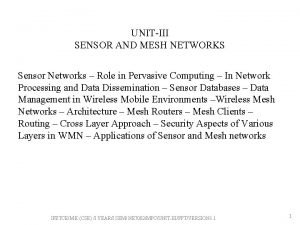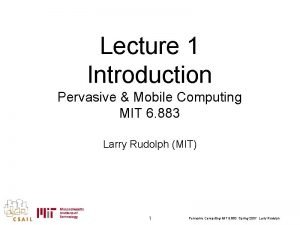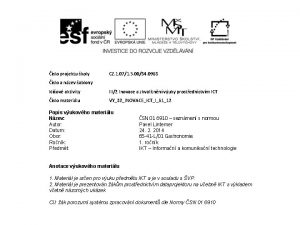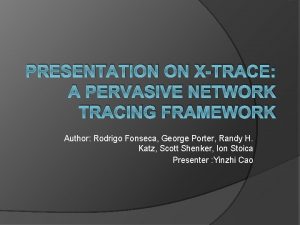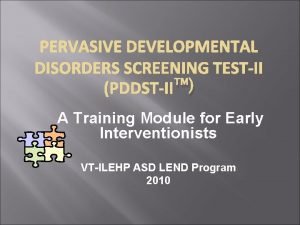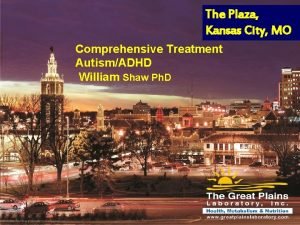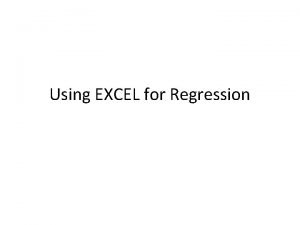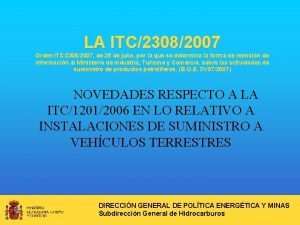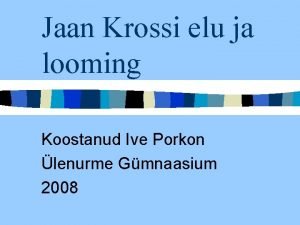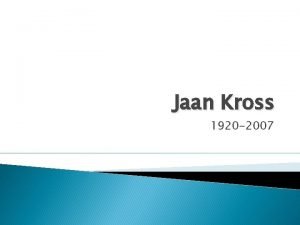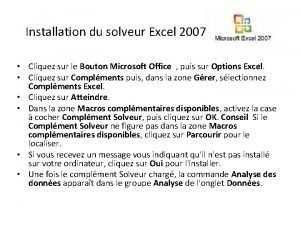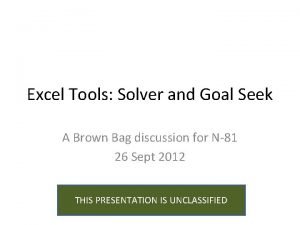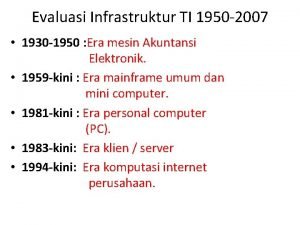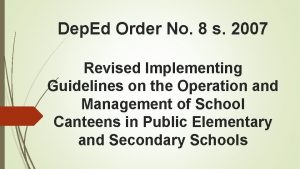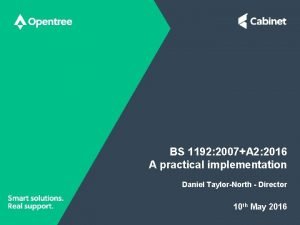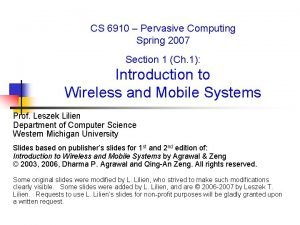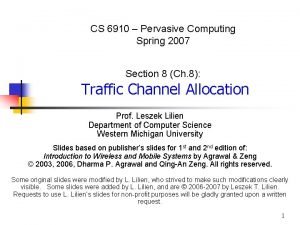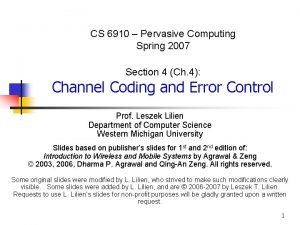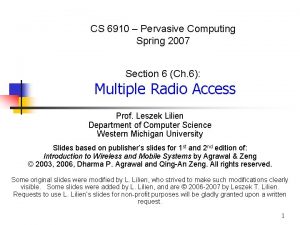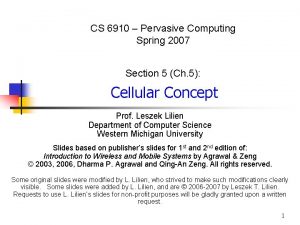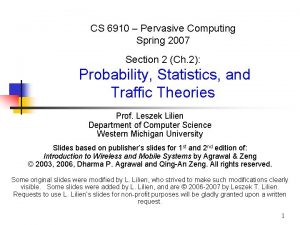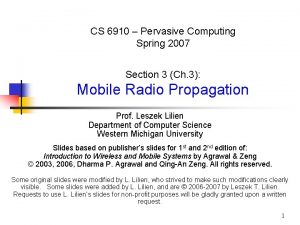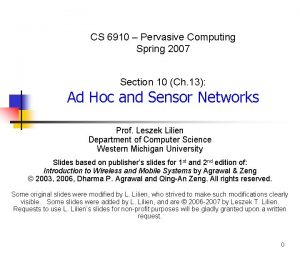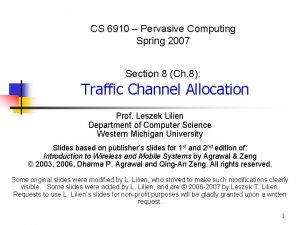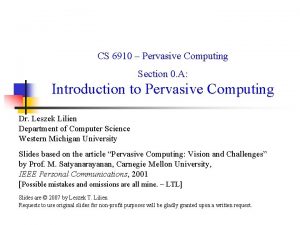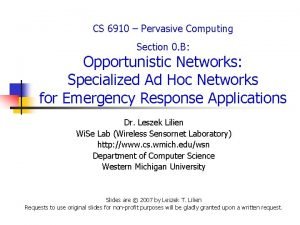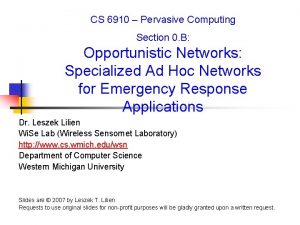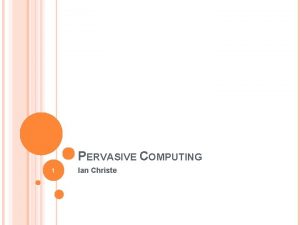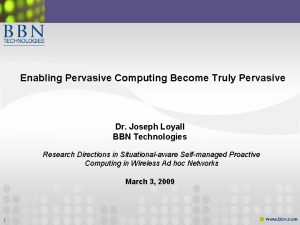CS 6910 Pervasive Computing Spring 2007 Section 10












































































- Slides: 76

CS 6910 – Pervasive Computing Spring 2007 Section 10 (Ch. 13): Ad Hoc and Sensor Networks Prof. Leszek Lilien Department of Computer Science Western Michigan University Slides based on publisher’s slides for 1 st and 2 nd edition of: Introduction to Wireless and Mobile Systems by Agrawal & Zeng © 2003, 2006, Dharma P. Agrawal and Qing-An Zeng. All rights reserved. Some original slides were modified by L. Lilien, who strived to make such modifications clearly visible. Some slides were added by L. Lilien, and are © 2006 -2007 by Leszek T. Lilien. Requests to use L. Lilien’s slides for non-profit purposes will be gladly granted upon a written request. 0

Chapter 13 Ad Hoc and Sensor Networks Copyright © 2003, Dharma P. Agrawal and Qing-An Zeng. All rights reserved (Modified by LTL) 1

Outline n n n Introduction Characteristics of MANETs Applications Routing n Table-driven Routing Protocols n Source-initiated On-demand Routing n Hybrid (Routing) Protocols Wireless Sensor Networks n General Wireless Sensor Networks n Fixed Wireless Sensor Networks Copyright © 2003, Dharma P. Agrawal and Qing-An Zeng. All rights reserved 2

13. 1. Introduction n A Mobile Ad hoc Network (MANET) n An ad hoc network n n n Formed as needed Does not require support from any existing newtork infrastructure Formal def. of MANET: n An autonomous system of mobile nodes or MSs (also serving as routers) connected by wireless links, the union of which forms a communications network modeled in the form of an arbitrary communication graph n Autonomous => does not require support from any existing network infrastructure n But might be able to use such support if available n n n Such support might be available from time to time Support could be: an Internet gateway or some fixed stations Notice how different from cellular network n Requires infrastructure (BS, MSC, backbone network, etc. ) => not ad hoc Copyright © 2003, Dharma P. Agrawal and Qing-An Zeng. All rights reserved 3

13. 1 Introduction – cont. 1 n Characteristics of MANETs: n Dynamically changing topology n Changing in an unpredictable manner n n n Limited power available to nodes (e. g. , a battery) Usually communicates only with neighboring nodes n n Among other reasons, to save power Peer-to-peer n n Since nodes are free to move No more or less “important” nodes Information transmission via store-and-forward n n Using multi-hop routing MSs also serve as routers Moving to a new location MS 2 MS 4 MS 3 (fig) Asymmetric = unidirectional - when xmission power of nodes on its ends is different (e. g. , MS 4 stronger than MS 7) Asymmetric link MS 5 MS 7 Symmetric link MS 1 MS 6 Copyright © 2003, Dharma P. Agrawal and Qing-An Zeng. All rights reserved 4

13. 1 Introduction – cont. 2 n As nodes move: n Connectivity changes n Topology information must be updated n n E. g. , MS 2 changes attachment: from MS 3 to MS 4 Communication characteristics for MANETs: n Each node equipped with a wireless transmitter and a receiver with an appropriate antenna n Impossible to have all nodes within each other’s radio range n When the nodes are close by (within each others radio range), they can communicate directly n n If direct comm. => no routing needed (one hop) Wireless connectivity modeled by a random multi-hop graph exists between the nodes Copyright © 2003, Dharma P. Agrawal and Qing-An Zeng. All rights reserved 5

13. 2 Characteristics of Ad Hoc Networks (revisited) n n Dynamic topologies n Network topology may change dynamically as the nodes are free to move Bandwidth-constrained, variable capacity links n Wireless links have typically lower capacity than wired n Realized throughput of wireless communication is lower than the radio’s maximum transmission rate n Link capacity is relatively low => congestion is common (collisions occurs frequently as application demand approaches link capacity) n Energy-constrained operation n Nodes in ad hoc network may rely on batteries or other limited energy sources n Energy conservation may be a dominant design factor Copyright © 2003, Dharma P. Agrawal and Qing-An Zeng. All rights reserved 6

13. 2 Characteristics of Ad Hoc Networks – cont. n Limited physical security n More prone to physical security threats than wired networks n n Incl. stealing mobile ad hoc devices Many attacks, incl. Eavesdropping, spoofing, and Do. S attacks are easier Decentralized network control n Eliminates single points of failure (=> better reliability) Scalability problems n As networks get large Copyright © 2003, Dharma P. Agrawal and Qing-An Zeng. All rights reserved 7

13. 3. Applications (Examples) n n n “Wearable” computing Defense applications Crisis-management applications n n Telemedicine n n E. g. , assistance by a surgeon for an emergency Tele-geoprocessing applications n n n Natural disasters, where the entire communication infrastructure is in disarray Queries dependent on location of the users Integrating geographical info systems (GIS) & GPS Virtual navigation n n Data from a remote database transmitted to navigation device in car or in hand May contain graphical representation of streets, buildings, and the latest traffic information n n May assist driver in selecting a route Education and Internet access n n K-12, continued education, etc. , for people in remote areas E. g. , email-by-bus in remote villages Copyright © 2003, Dharma P. Agrawal and Qing-An Zeng. All rights reserved 8

13. 4. Routing in MANETS n Many factors affecting routing in MANETs: n Models of topology n Selection of routers n Initiation of route requests n Specific underlying characteristics n n E. g. application-based characteristics Major goals in selecting routing protocols: n Provide the maximum possible reliability - use alternative routes if an intermediate node fails n Choose a route with the least cost n n n E. g. , minimal # of hops from source to destination Give the nodes the best possible response time and throughput Each node in MANETs expected to serve as a router n All execute the same routing protocol n Protocol calculates a route Copyright © 2003, Dharma P. Agrawal and Qing-An Zeng. All rights reserved 9

13. 4. 1. Need for Routing in MANETS n Goals for routing in MANETs: 1) Route computation must be distributed n Centralized routing in a dynamic network is usually too expensive 2) Routing computation should not involve the maintenance of global state n Would require xmitting a lot of information in dynamic topology 3) As few nodes as possible involved in route computation and state propagation n n But every node must have quick access to routes on demand Ensure infrequent topology updates for MANET portions that have no traffic 4) Each node must be only concerned about the routes to its destinations 5) Stale routes must be avoided or detected & eliminated 6) Broadcasts should be avoided n Broadcasts can be highly unreliable in MANETs 7) If topology stabilizes, the routes must converge to the optimal routes 8) It is desirable to have a backup route n Used when the primary route becomes stale Copyright © 2003, Dharma P. Agrawal and Qing-An Zeng. All rights reserved 10

13. 4. 1. Need for Routing in MANETS – cont. A major challenge in designing routing protocol: n Must know at least how to route a packet via its neighbors n Network topology can change frequently n Large # of network nodes (MSs) => Could have a lot of info to update n n Unless a clever protocol design Copyright © 2003, Dharma P. Agrawal and Qing-An Zeng. All rights reserved 11

13. 4. 2. Routing Classification n Types of routing protocols: 1) Proactive protocols n Keep routes ready at all times When a packet needs to be forwarded, the route is already known Example: distance vector routing protocols (more below) n n 2) Reactive (= on-demand) protocols n Route determination on demand Determine a route only when there is a packet to send Examples: flooding routing algorithms, ad hoc on-demand distance vector (AODV), temporarily ordered routing algorithm (TORA) (more below) n n n Proactive vs. reactive n In proactive: a route available immediately n In reactive: (1) a significant delay (2) significant traffic of control msgs (searching for a route) Copyright © 2003, Dharma P. Agrawal and Qing-An Zeng. All rights reserved 12

13. 4. 2. Routing Classification – cont. n Is proactive or reactive better for MANETs? n Pure proactive use too much bandwidth for control updating routing information n n Too keep it current all the time But topology changes are so quick that most routes never used – a waste! Pure reactive too slow for real-time applications (Orthogonal) types of routing protocols: 1) Table-driven protocols 2) Source-initiated on-demand protocols 3) Hybrid protocls More on all of them in the following subsections Copyright © 2003, Dharma P. Agrawal and Qing-An Zeng. All rights reserved 13

13. 5. Table-driven Routing Protocols n n “Table-driven” because: Each node maintains table(s) with routing information for every other nodes in the network Table-driven is proactive n n When the topology changes, updates are propagated throughout the network. Examples of table-driven routing protocols are: n n n Destination Sequenced Distance Vector routing (DSDV) Cluster-head Gateway Switch routing (CGSR) Wireless Routing Protocol (WRP) Copyright © 2003, Dharma P. Agrawal and Qing-An Zeng. All rights reserved 14

++SKIP++ 13. 5. 1. Destination-Sequenced Distance-Vector Routing (DSDV) n n Based on the Bellman-Ford algorithm (skipped – Ch. 12) Each mobile node maintains a routing table n n n Routing table updates are periodically transmitted Each entry in the table is marked by a sequence number n n In terms of number of hops to each destination Helps to distinguish stale routes from new ones, and thereby avoiding loops To minimize the routing updates, variable sized update packets are used n Depending on the number of topological changes Copyright © 2003, Dharma P. Agrawal and Qing-An Zeng. All rights reserved 15

13. 5. 2. Cluster-head Gateway Switch Routing (CGSR) n n Cluster-head gateway switch routing (CGSR) – a clustered multi-hop routing, heuristic MANET divided into clusters n For each cluster, a cluster-head (CH) elected n By a distributed CH selection algorithm n It modifies DSDV by using a hierarchical CH to route traffic Gateway nodes are bridges connecting cluster heads Frequent changes of CHs affect the performance n n Gateway Node Cluster Head Internal (noncluster) Node 1 0 7 8 Copyright © 2003, Dharma P. Agrawal and Qing-An Zeng. All rights reserved 9 16

13. 5. 2. Cluster Head Gateway Switch Routing (CGSR) n CGSR scenario - routing from Node 1 to Node 12: n n n Packet sent by Node 1 is first routed to its CH (2) The packet is routed from CH (2) to gateway (4) connecting to CH of another cluster (5) Packet routed from gateway (4) to the next CH (5) … Packet routed from gateway (10) to CH of destination cluster (11) Packet routed to destination node (12) 6 12 5 11 4 10 7 2 1 8 9 3 Copyright © 2003, Dharma P. Agrawal and Qing-An Zeng. All rights reserved Gateway Node Cluster Head Internal (noncluster) Node 17

++SKIP++ 13. 5. 3. The Wireless Routing Protocol (WRP) n Each node maintains 4 tables: n Distance table n Routing table n Link cost table n Message Retransmission List table (MRL) MRL contains the sequence number of the update message, a retransmission counter and a list of updates sent in the update message Copyright © 2003, Dharma P. Agrawal and Qing-An Zeng. All rights reserved 18

++SKIP++ 13. 5. 3. The Wireless Routing Protocol (WRP) – cont. n n n Nodes inform each other of link changes using update messages Nodes send update messages after processing updates from their neighbors or after detecting a change in the link If a node is not sending messages, it must send a HELLO message within a specified time to ensure connectivity If the node receives a HELLO message from a new node, that node is added to the table It avoids the “count to infinity” problem Copyright © 2003, Dharma P. Agrawal and Qing-An Zeng. All rights reserved 19

13. 6. Source-Initiated On-Demand Routing (the second category of routing protocols) n n Source-initiated on-demand routing - the 2 nd category (“family”) of routing protocols This family of protocols includes: 1) Ad hoc On-Demand Distance Vector (AODV) 2) Dynamic Source Routing (DSR) 3) Temporary Ordered Routing Algorithm (TORA) 4) Associativity Based Routing (ABR) 5) Signal Stability Routing (SSR) Copyright © 2003, Dharma P. Agrawal and Qing-An Zeng. All rights reserved 20

++SKIP++ 13. 6. 1. Ad hoc On-Demand Distance Vector Routing § AODV is an improvement over DSDV, which minimizes the number of required broadcasts by creating routes on demand § Nodes that are not in a selected path do not maintain routing information or participate in routing table exchanges § A source node initiates a path discovery process to locate the other intermediate nodes (and the destination), by broadcasting a Route Request (RREQ) packet to its neighbors Copyright © 2003, Dharma P. Agrawal and Qing-An Zeng. All rights reserved 21

++SKIP++ Route Discovery in AODV Protocol Hop 1 Hop 2 7 2 Source 1 Hop 3 5 8 Destination 3 6 4 (a) Propagation of Route Request (RREQ) Packet 7 2 5 Source 1 8 Destination 3 4 6 (b) Path Taken by the Route Reply (RREP) Packet Copyright © 2003, Dharma P. Agrawal and Qing-An Zeng. All rights reserved 22

++SKIP++ 13. 6. 2. Dynamic Source Routing § The protocol consists of two major phases: Route Discovery, Route Maintenance § When a mobile node has a packet to send to some destination, it first consults its route cache to check whether it has a route to that destination § If it is an un-expired route, it will use this route § If the node does not have a route, it initiates route discovery by broadcasting a Route Request packet § This Route Request contains the address of the destination, along with the source address Copyright © 2003, Dharma P. Agrawal and Qing-An Zeng. All rights reserved 23

++SKIP++ 13. 6. 2. Dynamic Source Routing – cont. 1 § Each node receiving the packet checks to see whether it has a route to the destination. If it does not, it adds its own address to the route record of the packet and forwards it. § A route reply is generated when the request reaches either the destination itself or an intermediate node that contains in its route cache an un-expired route to that destination. § If the node generating the route reply is the destination, it places the route record contained in the route request into the route reply. Copyright © 2003, Dharma P. Agrawal and Qing-An Zeng. All rights reserved 24

++SKIP++ 13. 6. 2. Dynamic Source Routing – cont. 2 Creation of Route Record in DSR Hop 1 2 <1> Source 11 Hop 2 <1, 2> 5 <1> 33 Hop 3 77 Hop 4 <1, 3, 5, 7> <1, 3, 5> 8 Destination <1, 3> <1> 6 44 <1, 4, 6> <1, 4> (a) Building Record Route During Route Discovery 7 2 5 Source 1 8 Destination 3 <1, 4, 6> 6 4 <1, 4, 6> (b) Propagation of Route Reply with the Route Record Copyright © 2003, Dharma P. Agrawal and Qing-An Zeng. All rights reserved 25

++SKIP++ 13. 6. 3. Temporarily Ordered Routing Algorithm (TORA) n n n TORA is a highly adaptive loop-free distributed routing algorithm based on the concept of link reversal TORA decouples the generation of potentially farreaching control messages from the rate of topological changes The height metric is used to model the routing state of the network Copyright © 2003, Dharma P. Agrawal and Qing-An Zeng. All rights reserved 26

++SKIP++ 13. 6. 3. TORA – cont. 1 Source H=3 H=2 H=1 H=0 Destination Illustration of Tora height metric Copyright © 2003, Dharma P. Agrawal and Qing-An Zeng. All rights reserved 27

++SKIP++ 13. 6. 3. TORA – cont. 2 n n n The protocol performs three basic functions: route creation, route maintenance, route erasure During the route creation and maintenance phases nodes use a height metric to establish a Directed Acyclic Graph (DAG) rooted at the destination Thereafter links are assigned a direction based on the relative heights Copyright © 2003, Dharma P. Agrawal and Qing-An Zeng. All rights reserved 28

++SKIP++ 13. 6. 3. TORA – cont. 3 2 (-, -) Source 1 5 (-, -) 3 (-, -) 7 (-, -) (0, 0) 6 (-, -) 4 (-, -) Destination 8 Figure 13. 6(a) – Propagation of the query message 2 (0, 3) Source 1 (0, 3) 3 (0, 3) 4 (0, 2) 5 (0, 2) 7 (0, 1) 8 6 (0, 1) Destination (0, 0) Node’s height updated as a result of the update message Copyright © 2003, Dharma P. Agrawal and Qing-An Zeng. All rights reserved 29

++SKIP++ 13. 6. 3 13. 6. 4. Associativity Based Routing (ABR) n n n n The three phases of ABR are: route discovery, route reconstruction, route deletion In ABR a route is selected based on the degree of stability associated with mobile node Association stability is defined by connection stability of one node with respect to another node over time and space Each node generates a beacon to signify its existence When received by neighboring nodes, the beacon causes their associativity tables to be updated The route discovery is accomplished by a Broadcast Query. Reply (BQ-REPLY) cycle When a discovered route is no longer desired, the source node initiates a Route Delete broadcast so that all the nodes along the route update their routing tables Copyright © 2003, Dharma P. Agrawal and Qing-An Zeng. All rights reserved 30

++SKIP++ 13. 6. 3 13. 6. 5. Signal-Stability -Based Routing (SSR) n n SSR selects a route based on the signal strength between nodes and a node’s location stability This route selection criteria has the effect of choosing routes that have a better link connectivity Copyright © 2003, Dharma P. Agrawal and Qing-An Zeng. All rights reserved 31

13. 7. Hybrid routing protocols n n Many of hybrid routing protocols 7 example protocols follow Copyright © 2003, Dharma P. Agrawal and Qing-An Zeng. All rights reserved 32

++SKIP++ 13. 7. Hybrid routing protocols – cont. 1 1) Zone Routing Protocol (ZRP): A node proactively maintains routes to destinations within a local neighborhood n The construction of a routing zone requires a node to first know who its neighbor, which is implemented through a MAC layer Neighbor Discovery Protocol 2) Fisheye State Routing (FSR): There are multi-level fisheye scopes to reduce routing update overhead in large networks n It helps to make a routing protocol scalable by gathering data on the topology, which may be needed soon 3) Landmark Routing (LANMAR): Uses a landmark to keep track of a logical subnet n The LANMAR routing table includes only those nodes within the scope and the landmark nodes themselves Copyright © 2003, Dharma P. Agrawal and Qing-An Zeng. All rights reserved 33

++SKIP++ 13. 7. Hybrid routing protocols – cont. 2 4) Location-Aided Routing (LAR): Exploits location information to limit the scope of routing n LAR limits the search based on the expected location of the destination node and thereby restricts and controls the flood of Route Request packets 5) Distance Routing Effect Algorithm for Mobility (DREAM) : Based on the distance effect and a node’s mobility rate n Each node can optimize the frequency at which it sends updates to the networks and correspondingly reduce the bandwidth and energy used 6) Relative Distance Micro-discovery Ad Hoc Routing (RDMAR): Based on the calculated relative distance between two terminals n The query flood is localized to a limited region centered at the source node Copyright © 2003, Dharma P. Agrawal and Qing-An Zeng. All rights reserved 34

++SKIP++ 13. 7. Hybrid routing protocols – cont. 3 7) Power Aware Routing: Power-aware metrics are used for determining routes n It reduces the cost, ensures that the mean time to node failure is increased, without any further delay in packet delivery Copyright © 2003, Dharma P. Agrawal and Qing-An Zeng. All rights reserved 35

++SKIP++ 13. 7. 7 B. Summary of Some Characteristics of Selected Protocols Protocol Route Flood for Acquisi- Route tion Discovery Delay for Route Discovery Multipath Capability Effect of Route Failure DSDV Compute No d a priori No No Updates the routing tables of all nodes WRP Compute No d a priori No No Ultimately, updates the routing tables of all nodes by exchanging MRL between neighbors DSR Ondemand, only when needed Not explicitly. The technique of salvaging may quickly restore a route Route error propagated up to the source to erase invalid path Yes Aggressive use of caching may reduce flood Copyright © 2003, Dharma P. Agrawal and Qing-An Zeng. All rights reserved 36

Summary of Some Characteristics of Selected Protocols – cont. Protocol Route Acquisition Ondemand, only when needed Flood for Route Discovery Yes. Controlled use of cache to reduce flood Delay for Route Discovery Yes Multipath Effect of Route Capability Failure No, although recent research indicate viability Route error propagated up to the source to erase invalid path TORA Ondemand, only when needed Basically one for initial route discovery Yes. Once the DAG is constructed, multiple paths are found Yes Error is recovered locally LAR Ondemand, only when needed Reduced by Yes using location information No Route error propagated up to the source ZRP Hybrid Only outside a source's zone No Hybrid of updating nodes' tables within a zone and propagating route error to the source AODV Only if the destination is outside the source's zone Copyright © 2003, Dharma P. Agrawal and Qing-An Zeng. All rights reserved 37

++SKIP++ 13. 7. 8. Multipath Routing Protocols n Pp. 324 - 333 Copyright © 2003, Dharma P. Agrawal and Qing-An Zeng. All rights reserved 38

13. 8. Wireless Sensor Networks n Wireless sensor networks (WSNs) n A class of ad hoc networks n A collection of hundreds or thousands of tiny, disposable (bec. low-cost) & low-power (bec. battery-operated) sensor nodes n n Communicating together to achieve an assigned task: monitoring & analysis of an area Sensor node in WSN n Converts a sensed physical attribute (e. g. , temperature) into data n Includes : n Sensing module n Communications module n Computing module n Memory module n Power source (usually a battery) Copyright © 2003, Dharma P. Agrawal and Qing-An Zeng. All rights reserved 39

13. 8. Wireless Sensor Networks – cont. 1 n Wired sensor networks n Example: wired sensornet within a plane n Known for years in many applications n Monitor critical physical parameters n Alert when anomalies perceived n Sensor locations carefully predesigned n Sensors distributed in strategic locations n # of sensor nodes can be huge n n n As many as needed to cover the monitored area Connected via wires Fault tolerance requirements n Avoid single points of failure n If work unattended => can not repair if failed n E. g. , in inhospitable or inaccessible milieus Copyright © 2003, Dharma P. Agrawal and Qing-An Zeng. All rights reserved 40

13. 8. Wireless Sensor Networks – cont. 2 n n Advances in technology enabled wireless sensornets (WSNs) n Esp. advances in miniaturization, low-cost sensors (& multisensors), wireless communications, batteries Low costs (due to advances in technology) enabled massive deployment of WSN nodes n No need for predesigned locations n Can drop them from a plane, a speeding car, etc. => no installation costs (saves more) Copyright © 2003, Dharma P. Agrawal and Qing-An Zeng. All rights reserved 41

13. 8. Wireless Sensor Networks – cont. 3 n Advantages of WSNs over wired sensornets 1) Ease of deployment n Deployed without careful design n E. g. , dropped from a plane 2) Extended range n At the same cost can cover a larger area n n n No need for infrastructure One large wired sensornet replaced by many smaller wireless sensornets at the same cost Can easily move from area to area 3) Fault tolerance n n n A design requirement! Must tolerate node failures (maybe reduces monitoring accuracy) Some fault tolerance is “natural” n Bec. failure of a sensor node is “masked” by other nodes collecting similar data in the same area 4) Mobility n No wires inhibiting mobility – not even for power n (batteries) Still WSNs less mobile than ad hoc networks Copyright © 2003, Dharma P. Agrawal and Qing-An Zeng. All rights reserved 42

13. 8. Wireless Sensor Networks – cont. 4 n Inherent limitations of WSNs 1) Limited energy (batteries, etc. ) 2) Low-bandwidth transmission 3) Error-prone transmission n Bec. xmitted at low power (Item 1 above) & over limited badwidth (Item 2 above) Copyright © 2003, Dharma P. Agrawal and Qing-An Zeng. All rights reserved 43

13. 8. Wireless Sensor Networks – cont. 5 n Design requirements for WSNs & their protocols 1) Maximize WSN lifetime n Discussed below 2) Accommodate dynamic, fast-changing physical parameters affecting WSNs, such as: (1) Power availability for nodes (2) Positions of nodes (3) Reachability n For a given node, which other nodes can it reach (4) Types of tasks executed by nodes n I. e. what attributes reports (such as temperature) the node monitors & Copyright © 2003, Dharma P. Agrawal and Qing-An Zeng. All rights reserved 44

13. 8. Wireless Sensor Networks – cont. 6 n Dealing with limited energy: n Design WSN & its protocols carefully to maximize WSN’s lifetime n One approach: balance energy use in such a way that all nodes die at approximately the same time n Once this happens, can replace the whole sensornet n Better than replacing individual nodes (impossible or inconvenient) Copyright © 2003, Dharma P. Agrawal and Qing-An Zeng. All rights reserved 45

13. 8. Wireless Sensor Networks – cont. 7 n Data exchange in WSN is fundamentally different than in other wireless networks n WSNs are data-centric networks n The interest is in “what is the data? ” rather than “where is the data? ” n n n E. g. , WSNs focus on attributes (e. g. , temperature, velocity) WSNs must efficiently respond to application/user queries asking for data => WSNs require different routing protocols then MANETs n Routing protocols for WSNs must be application-dataspecific Copyright © 2003, Dharma P. Agrawal and Qing-An Zeng. All rights reserved 46

13. 8. Wireless Sensor Networks – cont. 8 n Challenges in design of (application-data-specific) routing protocols for WSNs 1) No unique node ID to be used for routing n n Which is typical in traditional wired/wireless networks Bec. (#1) routing to/from a specific node is not required in datacentric WSNs n n Recall: It does not matter “where is the data? ” Bec. (#2) with the large # of nodes in WSNs, ID would be large n ID might be larger than amount of actual data being xmitted 2) Nodes often send aggregated data, not raw data n Adjacent nodes may have similar data, so aggregation cuts traffic 3) Routing protocols must be application-specific and datacentric n Bec. WSNs are application-specific and data-centric n E. g. , WSN may require protocol customized to very efficient delivery of data on a single attribute (e. g. , temperature) n Could be very inefficient for delivery of data on other single attribute, or delivery of multi-attribute data 4) Minimizing energy consumption Copyright © 2003, Dharma P. Agrawal and Qing-An Zeng. All rights reserved 47

13. 8. Wireless Sensor Networks – cont. 9 n Features of an ideal WSN 1) Attribute-based addresses n Composed of a series of attribute-value pairs n n Specify physical parameters to be sensed Example attribute address: “temperature>100 C, location=? ” n All nodes that sense temperature>100 C must report their locations 2) Location-awareness of nodes n A node often n (as in example in (1) above) needs to know its location Otherwise cannot provide sensed data (cf. example above) 3) Must react immediately to drastic environment changes n n Necessary for time-critical monitoring applications Can react slowly to non-critical changes/events n Saving bandwidth & energy at the cost of increased latency 4) Efficient handling of queries n n n Efficient xmission of queries from usesr/applications to appropriate nodes (=> need efficient routing!) Efficient xmission of answers to queries from nodes to users/applications (=> need efficient routing again!) Can reply with larger latency for noncritical changes/events n E. g. , can increase interval for reporting periodic data Copyright © 2003, Dharma P. Agrawal and Qing-An Zeng. All rights reserved 48

13. 8. 1. Case Study of a WSN n A sample WSN use scenario n WSN with temperature sensors around a factory n n Example queries: 1) 2) 3) 4) n To protect the factory & to protect population nearby Report immediately if water temp. in the NE quadrant < 5 C Retrieve today’s avg. water temp. in the SW quadrant For the next 2 hours, report if water temp. > 100 C Report in which areas water temp. was between 5 C & 100 C in the past 2 hours Conclusions for the scenario n Time-critical queries (as Query 1 above) must be answered immediately n Data from various nodes should be aggregated to reduce data traffic n n Aggregation usually involves adjacent nodes Queries are often “persistent” (or “duration-based”) Queries 2 -4 above) n (as Some “instantaneous” queries n Involve a snapshot of a single network state Copyright © 2003, Dharma P. Agrawal and Qing-An Zeng. All rights reserved 49

13. 8. 1. Case Study of a WSN – cont. 1 n Types of user queries 1) Historical query n Mainly for analysis of historical data stored at a BS n E. g. , “What was temp. 2 hours ago in the NW quadrant? ” 2) Instantaneous query (“one-time query“ in the textbook) n As Query 1 above n Gives a snapshot of a state of the network n E. g. , “What is the current temp. in the NW quadrant? ” 3) Persistent query n As Queries 2 -4 above n Mainly to monitor network over a time interval with respect to some parameters n E. g. , “Report temp. in the NW quadrant for the next 2 hours. ” Copyright © 2003, Dharma P. Agrawal and Qing-An Zeng. All rights reserved 50

13. 8. 1. Case Study of a WSN – cont. 2 n Important objectives for adapting to the inherently dynamic nature of WSNs 1) Exploit spatial diversity & density of sensors/actuators § Incl. building an adaptive node sleep schedule 2) Optimize the relationship between node density & network size 3) Keep optimizing the tradeoffs between data redundancy & bandwidth consumption …Details below… Copyright © 2003, Dharma P. Agrawal and Qing-An Zeng. All rights reserved 51

13. 8. 1. Case Study of a WSN – cont. 3 § Optimizing the tradeoffs between data redundancy & bandwidth consumption involves: a) Assuring that on deployment nodes are able to optimize these tradeoffs while: n Creating & assembling a network n Adapting to device failures & degradation n Managing mobility of sensor/actuator nodes n Reacting to changes in tasks & sensing requirements b) Adapting to traffic level n Certain nodes may detect an event that triggers heavy traffic n At other times traffic may be light c) Allowing fine control over WSN algorithms n More than just turning it on/off n E. g. , allow algorithms to optimize precision vs. energy Copyright © 2003, Dharma P. Agrawal and Qing-An Zeng. All rights reserved 52

13. 9. Fixed Wireless Sensor Networks n Fixed WSNs have pre-designed node locations n Application specific n Communicating via LOS infrared beam or conventional wireless communications Copyright © 2003, Dharma P. Agrawal and Qing-An Zeng. All rights reserved 53

13. 10. Other Issues in Wireless Sensor Networks n Note: n I believe that such section is missing in the textboook n The following issues are not just for Fixed WSNs, as organization of the Chapter 13 suggests … continued… Copyright © 2003, Dharma P. Agrawal and Qing-An Zeng. All rights reserved 54

13. 10. 1. Classification of Sensor Networks n Classification of sensor networks n Proactive networks n Nodes periodically switch on their sensors & transmitters, sense the environment & transmit the data of interest n n Reactive networks n Nodes react immediately to sudden or drastic changes in the value of the sensed attribute Once proactive/reactive network type is chosen, efficient routing protocols must be designed n Preferably using a suitable MAC sublayer protocol to avoid collisions Copyright © 2003, Dharma P. Agrawal and Qing-An Zeng. All rights reserved 55

13. 10. 2. Fundamentals of MAC Protocols for Wireless Sensor Networks n n n We said: “Efficient routing protocols must be designed, preferably using a suitable MAC sublayer protocol to avoid collisions” Radio xmission is broadcast in nature Can “simulate” unicast by all but one node (addressee) ignoring what they hear n This “simulation” is done by the MAC sublayer n Additionally, MAC coordinates accesses to the medium to avoid collisions n Coordinates by using appropriate channel allocation schemes for WSNs (next) Copyright © 2003, Dharma P. Agrawal and Qing-An Zeng. All rights reserved 56

13. 10. 2. Fundamentals of MAC Protocols for WSNs – cont. 1 n Categories of channel allocation schemes for WSNs 1) Static channel allocation n If there are N nodes, the bandwidth is divided into N equal portions (divided => no interference) n Can be divided in many ways: n n In frequency (FDMA) / In time (TDMA) / In code (CDMA) In space (SDMA: Space Division Multiple Access) In OFDM (Orthogonal Frequency Division Multiplexing) Works very well for small & fixed # of users 2) Dynamic channel allocation n No fixed assignment of bandwidth n Contention-based (collisions occur, resolved by retransmission) n Works very well for dynamic # of users Copyright © 2003, Dharma P. Agrawal and Qing-An Zeng. All rights reserved 57

13. 10. 2. Fundamentals of MAC Protocols for WSNs – cont. 2 n Data transmission in WSNs can use either flat or hierarchical topology n Hierarchical: forms clusters, uses them Copyright © 2003, Dharma P. Agrawal and Qing-An Zeng. All rights reserved 58

Material required for the final exam ENDS HERE Copyright © 2003, Dharma P. Agrawal and Qing-An Zeng. All rights reserved 59

13. 10. 3. Flat Routing in Sensor Networks n Routing issues in WSNs n In traditional wired networks each node is identified by a unique address, which is used for routing n Sensor networks, being data-centric do not, in general, require routing to specific nodes n Adjacent nodes may have similar data n So it is desirable to aggregate these data & only then send it n The requirements for the sensor network change with application, hence it is application-specific Copyright © 2003, Dharma P. Agrawal and Qing-An Zeng. All rights reserved 60

13. 10. 3. Flat Routing in Sensor Networks – cont. n Protocols for collecting data to answer queries 1) Directed diffusion n Query flooded throughout the network n Events start from some specific points & move outwards to reach the requesting node n This type of data collection does not fully exploit the feature of WSNs that adjacent nodes have similar data 2) Sensor Protocols for Information via Negotiation (SPIN) n Disseminates the information at each node to every node in the network 3) COUGAR n This is a warehousing approach n The data is extracted in a pre-defined manner and stored in a central database (BS) n n Query processing takes place on the BS COUGAR is a unique model for query representation in sensor networks Copyright © 2003, Dharma P. Agrawal and Qing-An Zeng. All rights reserved 61

13. 10. 4. Hierarchical Routing in Sensor Networks n n n n Most suitable for WSNs WSN consists of a Base Station (BS), away from the nodes, through which the end user can access data from the sensor network BS can transmit with high power Nodes cannot reply directly to the BS due to their low power constraints, resulting in asymmetric communication Copyright © 2003, Dharma P. Agrawal and Qing-An Zeng. All rights reserved 62

13. 10. 4. Hierarchical Routing – cont. 1 3. 2 Base Station 3 3. 3 2 2. 3 1. 0. 1 1. 0. 2 1 2. 2 1. 2. 5 1. 2. 4 1. 0. 3 1. 2 1. 1. 3 1. 1. 4 1. 1. 1 1. 2. 3 1. 2. 1 1. 2. 2 1. 1. 5 Simple sensor node First Level Cluster Head Second Level Cluster Head Copyright © 2003, Dharma P. Agrawal and Qing-An Zeng. All rights reserved 63

13. 10. 4. Hierarchical Routing – cont. 2 n Hierarchical routing protocols 1) Cluster-Based Routing Protocol (CBRP) n Here the cluster members just send the data to the cluster head (CH) n The CH routes the data to the destination n Not suitable for a highly mobile environment, as a lot of HELLO messages are sent to maintain the cluster Copyright © 2003, Dharma P. Agrawal and Qing-An Zeng. All rights reserved 64

13. 10. 4. Hierarchical Routing – cont. 3 2) Low-Energy Adaptive Clustering Hierarchy (LEACH) n LEACH is a family of protocols n It contains both distributed and centralized schemes n Use proactive updates n It utilizes randomized rotation of local cluster heads (CHs) to evenly distribute the energy load among sensors n It makes use of a TDMA/CDMA MAC scheme to reduce inter and intra-cluster collisions Copyright © 2003, Dharma P. Agrawal and Qing-An Zeng. All rights reserved 65

13. 10. 4. Hierarchical Routing – cont. 4 3) Threshold-sensitive Energy Efficient Network protocol (TEEN) (a reactive network routing protocol) n Targeted at reactive networks n n The first protocol developed for such networks At every cluster change time, the CH broadcasts the following to its members: n Hard threshold (HT): a threshold value for the sensed attribute n Soft threshold (ST): a small change in the value of the sensed attribute which triggers the node to switch on its transmitter and transmit Copyright © 2003, Dharma P. Agrawal and Qing-An Zeng. All rights reserved 66

13. 10. 4. Hierarchical Routing – cont. 5 Parameters Attribute > Threshold Cluster Formation Cluster Change Time Cluster Head Receives Message Time Line for TEEN Copyright © 2003, Dharma P. Agrawal and Qing-An Zeng. All rights reserved 67

13. 10. 4. Hierarchical Routing – cont. 6 n n The nodes sense their environment continuously The first time a parameter from the attribute set reaches its hard threshold value, the node switches on its transmitter and sends the sensed data The sensed value is stored in an internal variable, called Sensed Value (SV) The nodes will transmit data in the current cluster period only when the following conditions are true: n The current value of the sensed attribute is greater than the hard threshold n The current value of the sensed attribute differs from SV by an amount equal to or greater than the soft threshold Copyright © 2003, Dharma P. Agrawal and Qing-An Zeng. All rights reserved 68

13. 10. 4. Hierarchical Routing – cont. 7 n Important features of TEEN n Suitable for time-critical sensing applications n Message transmission consumes more energy than data sensing n n So the energy consumption in this scheme is less than the proactive networks The soft threshold can be varied At every cluster change time, the parameters are broadcast afresh, so the user can change them as required The main drawback: If the thresholds are not reached, then the nodes will never communicate Copyright © 2003, Dharma P. Agrawal and Qing-An Zeng. All rights reserved 69

13. 10. 4. Hierarchical Routing – cont. 8 4) Adaptive Periodic Threshold-sensitive Energy Efficient Network protocol (APTEEN) Functioning: n The cluster heads broadcasts the following parameters: n Attributes (A): This is a set of physical parameters which the user is interested in obtaining data about n Thresholds: This parameter consists of a hard threshold (HT) and a soft threshold (ST) n Schedule: This is a TDMA schedule, assigning a slot to each node n Count Time (CT): It is the maximum time period between two successive reports sent by a node Copyright © 2003, Dharma P. Agrawal and Qing-An Zeng. All rights reserved 70

13. 10. 4. Hierarchical Routing – cont. 9 TDMA Schedule and Parameters Slot for Node i Cluster Formation Frame Time Cluster Change Time line for APTEEN Copyright © 2003, Dharma P. Agrawal and Qing-An Zeng. All rights reserved 71

13. 10. 4. Hierarchical Routing – cont. 10 n n n The node senses the environment continuously Only those nodes which sense a data value at or beyond the hard threshold transmit Once a node senses a value beyond HT, it next transmits data only when the value of that attribute changes by an amount equal to or greater than the ST If a node does not send data for a time period equal to the count time, it is forced to sense and retransmit the data A TDMA schedule is used and each node in the cluster is assigned a transmission slot Copyright © 2003, Dharma P. Agrawal and Qing-An Zeng. All rights reserved 72

13. 10. 4. Hierarchical Routing – cont. 11 n Main features of the APTEEN scheme: n It combines both proactive & reactive policies n It offers a lot of flexibility by allowing the user to set the count-time interval (CT) & the threshold values for the attributes n Energy consumption can be controlled by changing count time & threshold values n Main drawback: additional complexity required to implement threshold functions & count time Copyright © 2003, Dharma P. Agrawal and Qing-An Zeng. All rights reserved 73

13. 10. 5. Hierarchical Versus Flat Topologies for Sensor Networks Hierarchical Flat Reservation-based scheduling Contention-based scheduling Collisions avoided Collisions present Reduced duty cycle due to periodic sleeping Variable duty cycle by controlling sleep time of nodes Data aggregation by cluster head Node on multi-hop path aggregates incoming data from neighbors Simple but non-optimal routing Routing is complex but optimal Requires global and local synchronization Links formed on the fly, without synchronization Overhead of cluster formation throughout the network Routes formed only in regions that have data for transmission Lower latency as multi-hop network formed Latency in waking up intermediate by cluster-heads is always available nodes & setting up the multi-hop path Energy dissipation is uniform Energy dissipation depends on traffic patterns Energy dissipation can not be controlled Energy dissipation adapts to traffic pattern Fair channel allocation Fairness not guaranteed Copyright © 2003, Dharma P. Agrawal and Qing-An Zeng. All rights reserved 74

The End of Section 10 (Ch. 13) 75
 Mobile computer wikipedia
Mobile computer wikipedia Pervasive and mobile computing
Pervasive and mobile computing Pervasive computing ppt
Pervasive computing ppt Mobile and pervasive computing
Mobile and pervasive computing Pervasive and mobile computing
Pervasive and mobile computing Stn 88 6101
Stn 88 6101 Iras 05280-6910
Iras 05280-6910 čsn 01 6910
čsn 01 6910 The heavenly banquet
The heavenly banquet Cast of spring, summer, fall, winter... and spring
Cast of spring, summer, fall, winter... and spring Spring, summer, fall, winter... and spring
Spring, summer, fall, winter... and spring X-trace: a pervasive network tracing framework
X-trace: a pervasive network tracing framework Salesforce company overview
Salesforce company overview Specific and pervasive boundaries for behavior
Specific and pervasive boundaries for behavior Pervasive developmental disorder screening test
Pervasive developmental disorder screening test Pervasive developmental disorder
Pervasive developmental disorder Melancholic features
Melancholic features Conventional computing and intelligent computing
Conventional computing and intelligent computing What line types are usually omitted from sectional views
What line types are usually omitted from sectional views When should a revolved section be used
When should a revolved section be used What symbol is commonly used for half section view
What symbol is commonly used for half section view Section 2 describing energy
Section 2 describing energy Concept mapping chapter 10 meiosis 1 and meiosis 2
Concept mapping chapter 10 meiosis 1 and meiosis 2 Cara mengaktifkan macro di excel 2010
Cara mengaktifkan macro di excel 2010 Regression analysis excel 2007
Regression analysis excel 2007 What is the mental health act 2007
What is the mental health act 2007 Delhi fire service act
Delhi fire service act Df 24/1997
Df 24/1997 Tarikh puasa 2007
Tarikh puasa 2007 Dijana dominis prester
Dijana dominis prester How to create multiple choice questions in word 2007
How to create multiple choice questions in word 2007 Sale of goods and supply of services act 2007
Sale of goods and supply of services act 2007 June 2010 physics regents answers
June 2010 physics regents answers Power pivot 2007
Power pivot 2007 Inei censo 2007 resultados
Inei censo 2007 resultados Procurement act 2007
Procurement act 2007 Ods to excel
Ods to excel Microsoft word 2007 dapat dijalankan dengan menggunakan
Microsoft word 2007 dapat dijalankan dengan menggunakan Office project 2007
Office project 2007 Office visio 2007
Office visio 2007 Microsoft publisher 2007
Microsoft publisher 2007 Curso word 2007
Curso word 2007 Maturita 2007
Maturita 2007 Lineamientos de política del sector salud al 2021 ppt
Lineamientos de política del sector salud al 2021 ppt 29052007
29052007 Sentenze gemelle 348 e 349 del 2007
Sentenze gemelle 348 e 349 del 2007 Mityc risp
Mityc risp 45/prt/m/2007
45/prt/m/2007 Kirjanik 1920-2007
Kirjanik 1920-2007 Kirjanik 1920-2007
Kirjanik 1920-2007 Tutorial project 2007
Tutorial project 2007 Ms word view tab
Ms word view tab Solveur excel
Solveur excel Crear indice en word 2007
Crear indice en word 2007 Putting people first 2007
Putting people first 2007 Decreto legislativo 21 novembre 2007 n. 231 aggiornato 2021
Decreto legislativo 21 novembre 2007 n. 231 aggiornato 2021 Office 2007 wikipedia
Office 2007 wikipedia How to create mail merge in ms word 2007
How to create mail merge in ms word 2007 Power failure by andrew forster
Power failure by andrew forster Google sky 2007
Google sky 2007 Plastic fingerprint
Plastic fingerprint Sumxmy
Sumxmy Solver excel 2007
Solver excel 2007 Visual basic 2007
Visual basic 2007 2007-1930
2007-1930 Groove 2007
Groove 2007 Who building blocks framework 2007
Who building blocks framework 2007 Canteen funds
Canteen funds Dau 2007
Dau 2007 Who building blocks framework 2007
Who building blocks framework 2007 Middle school 2008 fashion
Middle school 2008 fashion Calendario mayo 2007
Calendario mayo 2007 Dose response curve definition apes
Dose response curve definition apes Unemployment rate formula
Unemployment rate formula Word 2007 word art
Word 2007 word art Bs 1192
Bs 1192 Scaling bridge
Scaling bridge


